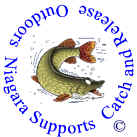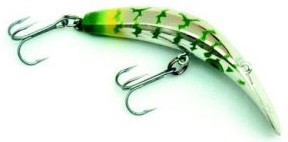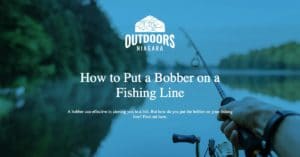 An
An
Outdoors Niagara Exclusive!
Fishing the Niagara
River What’s a
Niagara Yellow
Sally?
Back to Home Page
Go to Fishing the Niagara River with John Long
What’s a Yellow Sally,
a spinner, a 3-way
and a worm? In some regions a yellow sally is a dry fly that
resembles a adult stone fly and tied on hooks like #14’s to #18’s. In this
region, I don’t know what it a sally represents except it is not a
dry fly nor fished with a fly rod. Complete opposite for Lake Erie and Niagara
River Fishermen. This regional Yellow Sally and it’s sister colors have survived
successfully for well over a half a century.
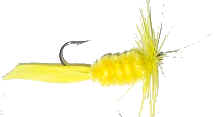 Typical TypicalYellow Sally |
Fishing the Niagara River creates a challenge for first time fishermen trying their luck in the Mighty Niagara. Whether you are fishing from a boat or from shore there are a lot of things to learn. It’s not like fishing in a pond or a creek or a lake where currents sometimes go unnoticed. Some methods, some lures and some baits used will be discussed here. It is hoped this will be a help to first time visitors and also a brush up for our local fishermen. This is favorite with walleye & bass fishermen. |
| First, lets start with the time proven yellow sally and spinner. A lot of people outside the area are puzzled at what a yellow sally is. The yellow sally is a hand tied fly and was never duplicated in the oriental countries because of its small market of interest. Even other domestic manufacturers show any interest. Locally we have always had to depend on our local fly tiers and they are tied as well today as they were 65 years ago. The yellow sally was developed by the early Lake Erie and Niagara River walleye and bass fishermen that many years ago. Colors varied as you can see in the photos. The flies are generally tied on a #1 or a #1/0 size Sproat hook with straight eye as you can see in the top photo. |
|
 Light Erie Fly |
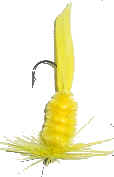 Yellow Sally |
 Dark Erie Fly |
The top three flies were the tops
in colors used in the past and still highly effective today.
The “red ibis” fly below was also a great producer as was the black
knat. [all black] and the white miller.
There are many colors of this type of fly in use today as they have been
created using modern day materials like fluorescent chenille’s. There is
also
a bumble bee pattern that is tied with black & yellow chenille and
with a fluorescent yellow and black chenille.
The original “red ibis” fly was all red
with red tail and all red chenille.
Fluorescent colors didn’t come into play until the late 70’s
 Red Ibis |
 Fluorescent Green |
 Fluorescent Pink |
Rigging the fly for use in the Niagara River is a fairly
simple matter as shown here:
| The following is part of an article written by John Long Sr. in 1996 for a magazine. Long is a life long outdoorsman and back in the 1950’s he fished the Niagara River extensively and back then you were able to sell your fish. Long did, and it helped him pay for his college tuition. Long went on to be an outdoor writer, outdoor TV producer among many other outdoor related vocations. Long has been New York Governor George Pataki’s consultant and advisor on conservation issues. |
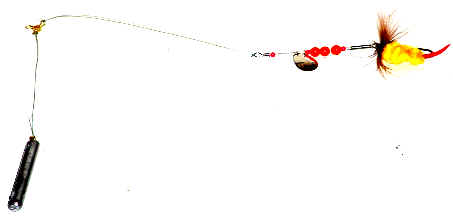 This is a typical Yellow Sally rig with a spinner and drop sinker off a 3-way swivel. The empty “eye” on the swivel is where the line is attached from the reel. The only thing missing here is the Sally must be tipped with a nightcrawler! ……Notice the sinker. They come in different sizes and it is recommended you start with the 1 ounce size and change it depending on wind and drift conditions. |
FROM: SOMETHING WONDERFUL The old timers never varied |
| Finally, attach an 8-inch length of 6-pound test leader to the last eye of the swivel. Depending on the wind, add a sinker of somewhere near an ounce. Add a half of a night crawler to the hook and you are in business. Fish right on the bottom, bouncing or carefully dragging with just enough line out to touch. When a fish hits I always allow it to tug at the bait for a second or two before I strike. Other fishermen disagree. You’ll have to develop your own technique. Some anglers, especially on quiet days, cast and let the rig settle to the bottom then slowly reel in as they drift. This works well where there are few snags. Some drifts have more snags than others, but all have areas where you can comfortably drag bottom. I always have the most problems at the Artpark Drift and the Coast Guard Drift, although the Stella Drift and the Back Drift also have bad spots. You’ll soon learn the areas that require special care. The light leader on your sinker will allow you to break off a lot of snags without losing all of your rig. Don’t let the snags keep you from fishing right on the bottom. That is where the walleyes seem to stay. One advantage that the old timers’ boats had over most of today’s were oarlocks and the ability to keep the boat drifting straight by keeping one oar active in the water. An electric trolling motor can be used for the same purpose today. Modern boats have more freeboard and are higher in the water. Wind has much more effect on them. They will drift better in light winds, but mush faster in stronger winds. A heavier sinker may solve the problem in these cases and some fishermen resort to backtrolling. NEXT: Fishing with hard baits
FALL NIAGARA |
|
Go to Fishing with egg sacs
Go to Fishing the Niagara River with John Long
COMING SOON: FISHING THE
NIAGARA “BAR” !
Wife says “Where are you goin’?”
You tell her “I’m going to the bar” She says “why are you taking
the boat?” You tell her “because the bar I’m going to, I need
boat!” ……..Let her figure it out!
